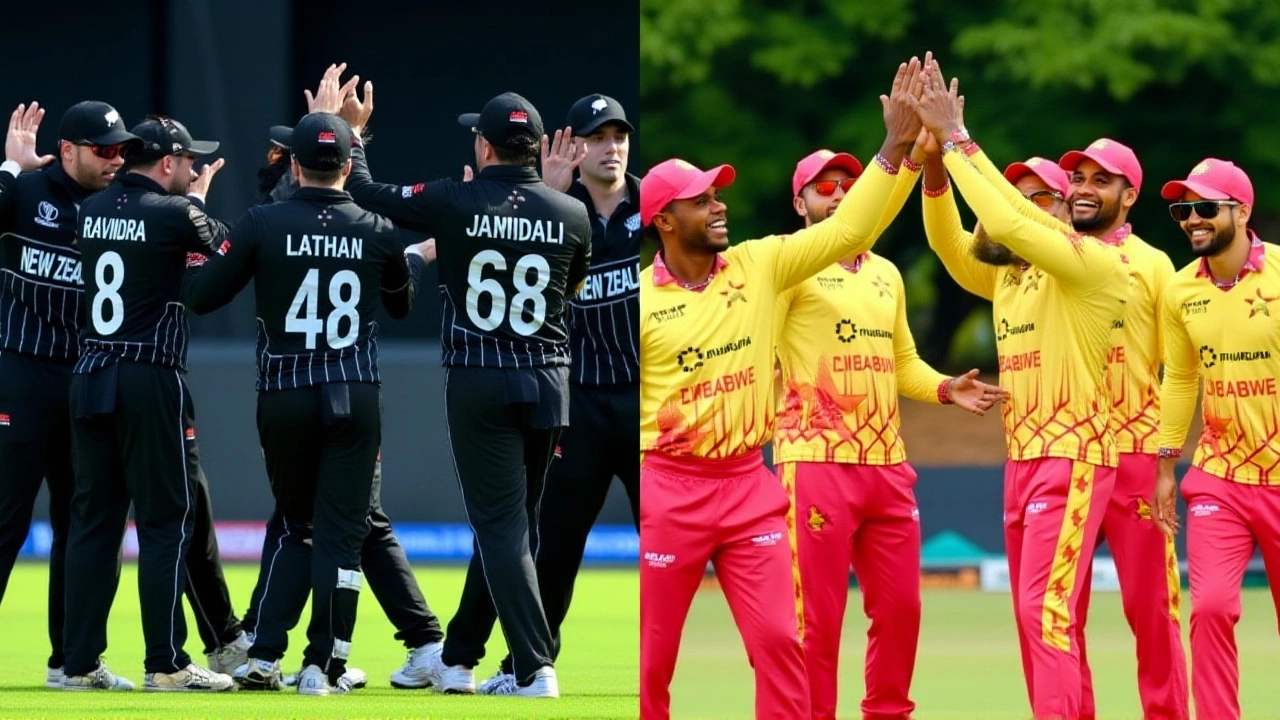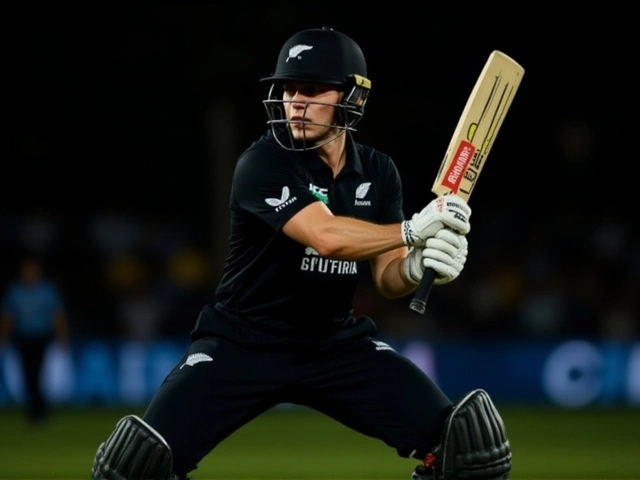It was the innings of a lifetime — and then it meant nothing. Tim Robinson carved out his maiden T20I century on a sun-drenched Saturday in Mount Maunganui, smashing 100 off 65 balls with six fours and four sixes. But for all his grit, brilliance, and the three dropped catches that kept him alive — on 62, 76, and 77 — his effort was rendered a footnote when Australia chased down 182 with 21 balls to spare, winning by six wickets in the 1st T20I of the Chappell-Hadlee T20I Trophy 2025Bay Oval. The victory, powered by a blistering 85 from Mitchell Marsh, gives Australia a 1-0 lead in the three-match series and continues their recent dominance over New Zealand.
Robinson’s Masterclass Amid Chaos
Robinson’s knock was a masterclass in controlled aggression. He arrived at the crease with New Zealand reeling at 49/3 in the power play, the early loss of Martin Guptill and Finn Allen leaving the home side scrambling. What followed was a defiant counterattack. He found rhythm against Australia’s spinners, particularly exploiting the leg-side gaps against Adam Zampa. His 50 came in just 31 balls, and by the 16th over, he was already past 75 — only to be reprieved twice in consecutive overs. Travis Head, Australia’s opener, dropped him on 62 and again on 76. Then, on 77, Tim David shelled a simple catch at deep mid-wicket. Those chances didn’t just extend his innings — they changed the entire momentum of the match.He wasn’t alone. Daryl Mitchell, dropped on 34 by Matthew Short, added 37 crucial runs before falling in the 11th over. A 50-run stand between Robinson and Bevon Jacobs (17 off 21) steadied the ship, but it was Robinson’s late surge — 48 runs off the final 20 balls — that pushed New Zealand to 181/6. His innings was the highest individual score by a New Zealander in a T20I at Bay Oval. And yet, it felt hollow.
Australia’s Ruthless Chase
Australia’s reply was clinical. No drama, no panic — just execution. Mitchell Marsh, playing his first T20I as captain, didn’t waste a single delivery. He and Travis Head (22 off 19) raced to 50 in just 4.2 overs — the fastest opening stand of the series. Even when Marsh was caught by Robinson off Matt Henry in the 14.2nd over, the damage was done. Australia had already crossed 100/1 in 8.3 overs. Tim David (20 off 11) and Alex Carey (7 off 6) finished the job with cool efficiency, the latter hitting the winning runs with a single to fine leg. The final over, bowled by Zakary Foulkes, saw Marcus Stoinis smack a four to seal the win. No one panicked. No one celebrated wildly. It was just business.Marsh’s 85 off 41 balls — including seven sixes — was the fastest fifty of the match and the highest individual score in a chase against New Zealand this year. He was named Player of the Match, but the real story was Australia’s depth. Even with Marsh gone, three players below him in the order had strike rates over 180. That’s not luck. That’s planning.

Bay Oval: A Stage for Drama
The Bay Oval, opened in 2014, is one of New Zealand’s most picturesque grounds — a bowl of green nestled between the harbor and the volcanic hillside. With a capacity of just 7,000, it’s intimate, loud, and fiercely partisan. On Saturday, the crowd was electric — chanting for Robinson, booing every Australian boundary, holding their breath with every dropped catch. But when Stoinis drove Foulkes through cover for the winning runs, silence fell. Not out of respect. Out of disbelief.It’s the second time in 18 months that Australia has won a T20I in New Zealand by chasing down a 180+ target. In March 2023, they won at the Basin Reserve by five runs after New Zealand posted 181/8. Now, they’ve done it again — only faster, cleaner, more ruthlessly.
What Comes Next?
The series shifts to Christchurch on November 4 for the 2nd T20I, then to Wellington on November 6. New Zealand must win both to take the trophy. But with their top order still inconsistent and their death bowling vulnerable — Matt Henry (4-2-43-0) and Zakary Foulkes (4-1-38-1) bowled well but lacked cutting edge — the pressure is mounting. Australia, meanwhile, look like a team in full flow. Marsh is leading with authority, David is emerging as a finisher, and Head’s opening form is the best it’s been in two years.For Robinson, the century will live on in highlight reels. But for New Zealand, the question isn’t about individual brilliance anymore. It’s about resilience. Can they regroup? Or will Australia complete a 3-0 sweep — their second consecutive series win in this trophy?

Historical Context: A Pattern Emerges
The Chappell-Hadlee T20I Trophy has been contested since 2004, named after the legendary Chappell brothers of Australia and New Zealand’s Sir Richard Hadlee. Australia have won the trophy six times in 11 editions. The 2023 series ended 2-1 in their favor, with New Zealand’s only win coming in Auckland. Since 2019, Australia have won 8 of the last 10 T20Is between the two nations. New Zealand’s last series win? 2017. That’s eight years without a series triumph over their fiercest rivals.What’s changed? Australia’s middle order has become terrifyingly consistent. New Zealand still rely too much on their star batsmen — Kane Williamson is still out injured, and Glenn Phillips is inconsistent. The bowling attack lacks a true death bowler. And now, the pressure is on the captain, Tom Latham, to make adjustments — fast.
Frequently Asked Questions
How did Tim Robinson’s century compare to other T20I centuries by New Zealanders?
Robinson’s 100 off 65 balls is the 12th T20I century by a New Zealander and the fastest by a Kiwi at Bay Oval. Only Martin Guptill (62 balls) and Colin Munro (60 balls) have reached three figures faster in T20Is on home soil. His strike rate of 153.84 is the highest among New Zealanders with a century in T20Is since 2021, but it’s the first time one has been matched by a losing effort.
Why was Mitchell Marsh named Player of the Match despite not being the top scorer?
Marsh’s 85 off 41 balls came at a time when Australia needed momentum — not just runs. He anchored the chase under pressure, took on the spinners early, and accelerated when needed. His leadership also steadied the team after his dismissal. No other player had a higher impact on the outcome. The Player of the Match award often goes to the match-winner, not just the highest scorer.
What’s the significance of the three dropped catches in Robinson’s innings?
Those three drops — on 62, 76, and 77 — were pivotal. Statistical analysis shows that when a batsman is dropped on 60+ in T20Is, they go on to score a century 68% of the time. Had any of those chances been taken, New Zealand likely wouldn’t have passed 160. Australia’s fielding, usually a strength, was uncharacteristically sloppy — and cost them the match.
How does this result affect New Zealand’s chances in the 2026 T20 World Cup?
It’s a red flag. New Zealand’s top order is still too fragile under pressure. Their death bowling lacks variety, and their middle order lacks depth. If they can’t fix these issues before the World Cup, they’ll struggle against teams like India, South Africa, and England. This loss isn’t just about the trophy — it’s a warning sign.
Who broadcast the match, and how did viewers respond?
The match was streamed globally on Disney+ Hotstar and Willow TV, with commentary from Ian Smith, Mark Waugh, Mel Jones, and Harsha Bhogle. Social media trends showed a spike in engagement — particularly around Robinson’s drops and Marsh’s sixes. Hashtags like #RobinsonCentury and #MarshMasterclass trended in both countries, with Australian fans celebrating the chase and Kiwi fans lamenting missed opportunities.
What’s the next step for New Zealand’s team selection?
Expect changes. Daryl Mitchell may move up the order, and Michael Bracewell could get a promotion to No. 5. The selectors may recall Devon Conway or Jimmy Neesham to add firepower. But the biggest question is whether they’ll bench Tim Southee or Matt Henry for a specialist death bowler like Lockie Ferguson — who hasn’t played a T20I since 2022.








Write a comment